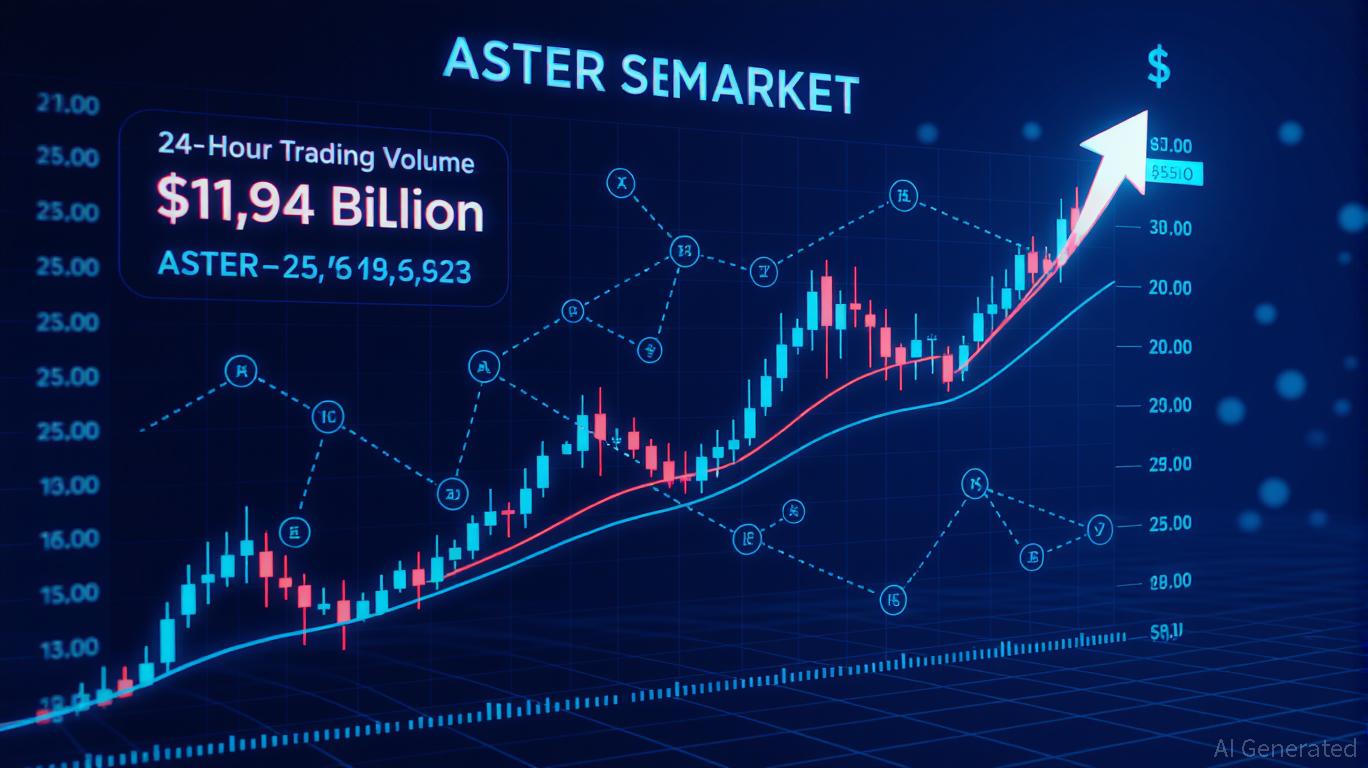Aster DEX's Latest Rally: Is This the Dawn of a New Age for Decentralized Exchanges?
- Aster DEX's 2025 upgrades enabled ASTER token as collateral for perpetual trading, boosting TVL to $14.98B and 24-hour volume to $11.94B. - CZ's $2M ASTER purchase triggered 800% volume surge, while Coinbase's roadmap inclusion signaled institutional validation of its hybrid order-matching model. - The 80% margin ratio and 5% fee discount redefined token utility, attracting both retail and institutional traders through capital efficiency. - Regulatory risks from zero-knowledge Aster Chain and sustainabil
On-Chain Innovation: Evolving from Speculation to Real Utility
The protocol update on November 5, 2025, marked a significant shift for Aster DEX, moving away from conventional token models. By permitting ASTER holders to leverage their tokens as collateral, the platform shifted ASTER’s role from a speculative asset to a foundational part of its ecosystem. On-chain experts highlight that this approach lessens dependence on outside collateral and encourages users to hold ASTER long-term through fee incentives and improved margin efficiency, as detailed in a
The timing of these changes was also carefully planned. Just three days before the upgrade, Binance founder Changpeng Zhao (CZ) acquired $2 million in ASTER tokens, which led to an 800% jump in daily trading volume to $2 billion and a 30% price increase, as shown in a
User Growth: Trading Volume, Wallet Expansion, and Institutional Support
The data paints a striking picture. By November 10, 2025, Aster DEX had reached a daily trading volume of $11.94 billion, overtaking Hyperliquid and Lighter to become the leading perpetual decentralized exchange (Perp DEX), according to a
Coinbase’s decision to add ASTER to its official roadmap on November 7, 2025, further reinforced Aster’s upward trajectory. DeFi analysts note that this move reflects rising institutional trust in Aster’s hybrid model, which combines on-chain and off-chain order matching and emphasizes privacy, as outlined in a

Strategic Impact and Looking Ahead
Aster DEX’s continued growth depends on its ability to maintain this pace. The collateral mechanism, which locks ASTER into active trades, reduces circulating supply and creates a feedback loop: greater utility boosts value, which then draws in more users. Still, there are hurdles ahead. The platform faces regulatory challenges, especially as it prepares to debut Aster Chain with zero-knowledge proofs—a feature that could appeal to privacy-focused traders but also invite regulatory attention, as the
For those investing, the main concern is whether Aster’s advancements can be scaled up without losing its decentralized nature. Its hybrid approach, balancing transparency on-chain with efficient off-chain execution, could serve as a model for future DeFi projects. However, as with any rapidly expanding asset, caution is necessary. The 800% volume increase following CZ’s purchase is impressive, but without ongoing innovation and ecosystem growth, it may not be sustainable in the long run.
Conclusion
The upgrades introduced by Aster DEX in November 2025 have significantly altered the DeFi sector. By expanding ASTER’s functionality and attracting institutional interest, the platform has shown that decentralized exchanges can compete with centralized ones. The real challenge will be sustaining this growth as the market shifts. For now, Aster’s rise is more than just a tale of technical progress—it’s an example of how timing, institutional backing, and user-focused design can come together to transform an industry.
Disclaimer: The content of this article solely reflects the author's opinion and does not represent the platform in any capacity. This article is not intended to serve as a reference for making investment decisions.
You may also like
YFI has dropped 41.08% over the past year, experiencing fluctuating short-term movements.
- YFI fell 0.02% in 24 hours, 5.94% weekly, but rose 0.04% monthly amid 41.08% annual decline. - Price swings reflect mixed short-term stability and long-term fragility driven by macroeconomic factors. - Backtesting showed -2.15% average return post-41.08% annual drops, with no abnormal gains detected. - Market dynamics suggest prolonged consolidation rather than isolated events caused the sustained decline.
Solana News Today: Solana ETFs Signal Crypto's Move Into the Mainstream, Surpassing Bitcoin
- VanEck files Form 8-A for its Solana spot ETF (VSOL), signaling imminent Nasdaq launch after October S-1 registration. - 10 Solana ETFs await SEC approval as institutional demand grows for regulated access to the blockchain's ecosystem expansion in DeFi, NFTs, and staking. - Bitwise's first Solana ETF attracted $420M in its debut week, forcing competitors to accelerate strategies amid evolving regulatory pathways. - Strong institutional inflows ($421M in November) pushed SOL toward $168, though volatilit
ALGO experienced a 16.57% quarter-over-quarter decline due to product transitions and fluctuations in the market.
- ALGO fell 16.57% QoQ amid market volatility and product transition challenges at Alargo. - Alargo replaced Akaroid with NHD, achieving 80% YoY sales growth through direct doctor engagement. - AXI's margin optimization doubled contribution per piece despite 60% volume decline from low-margin delistings. - ARCO Pharma's rebranding and scientific training aims to strengthen pharmacist relationships and market position. - Analysts note long-term margin potential but warn of short-term revenue risks from tran
BCH Drops 1.35% Today as Loan Expansion Slows and Profitability Faces Challenges
- BCH fell 1.35% in 24 hours amid weak loan growth and reduced inflation adjustment income, with 60% revenue tied to net interest income. - Institutional holdings rose 12.75% but shares held dropped 3.53%, as Bridge Builder increased exposure while Baillie Gifford cut holdings by 289.93%. - Goldman Sachs maintains Neutral rating with 0.70% upside, while backtesting shows mixed post-earnings performance with limited statistical significance from two data points.